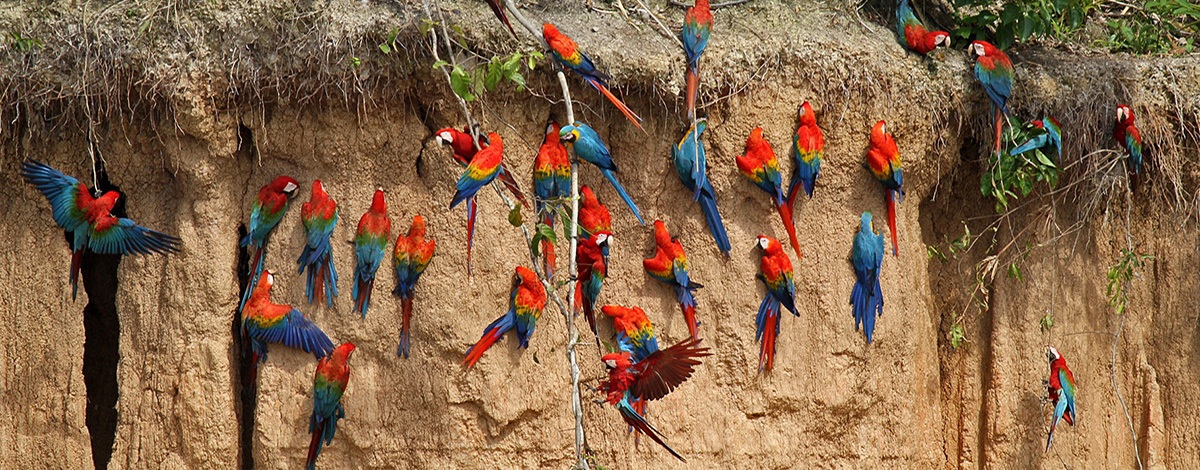
- Macaw’s clay lick - PERU MYSTERIES
- AN EXCITING ADVENTURE

The word "Collpa" (macaw’s clay lick) derives from Quechua which means salt land and are the places where many species of animals congregate to lick and eat a variety of minerals in which these places are rich (different birds and mammals). The earth of these places contains calcium, sodium and mineral salts that complement the nutrition and reduce the toxic effects of the alkaloids contained in the leaves, fruits and seeds that the animals consume. There are many places with these characteristics in the jungle, especially on the shores and cliffs of rivers
The macaw’s clay lick, are clay promontories that are usually found on the banks of some jungle rivers where hundreds of parakeets, parrots and macaws gather to ingest clay as a complement to their diet. There are two theories why parakeets, parrots and macaws consume clay. The first, the most accepted, is that clay contains salts and minerals that complement your daily diet. The other theories argues that, parakeets parrots and macaws consume green fruits and seeds that contain tannins, they use the salts of the collpa as a natural antacid. Tannins are toxic substances that produce many plants as a natural defense to avoid being consumed by certain animals. It is not known exactly how many tannins the parrots can ingest, but the collpa could reduce the toxic effects. Most likely, psittácids consume clay due to a combination of both theories.
Thanks to the hiding places, located strategically in front of the clay licks, one observes with amazement the activity. The first to arrive are the parakeets, followed by the parrots and finally the macaws. These birds congregate in the treetops as they begin to appear flying in pairs, in trios or quartets (in the case of couples with one or two young). The color of these spectacular birds is accentuated even more with the sunrise; the same happens with the collpa that suddenly turns into an intense ocher color.
The parrots, parrots and macaws perch one by one in the branches of the trees, are sociable birds that in the meeting it seems that they were talking with each other. Many scientists classify the intelligence of certain psittacids on the same level as that of dolphins or chimpanzees. It is fun to observe their behavior; They "groom" each other, emit deafening sounds, hang beak down a leg, they peck, until at any moment the small and Amazon macaws begin to fly from one side of the lick to the other until after several attempts go down to the wall and begin to take positions. The green plumage of small species allows them to camouflage themselves with the vegetation that grows there. Then the big macaws begin to fall wide open with more confidence to eat the clay.
This multicolored spectacle that is given to us, is a whim of nature, both when the birds fly and when they are at the clay lick. Many times you can see between 80 to 90 large macaws eating at the clay lick at the same time, not counting the least 300 parakeets and parrots. The macaws spend most of the time in the trees near the clay lick; for this reason they are exposed to attacks by predators such as larger birds of prey. This is why these birds are very alert and nervous, and at the slightest cry of alarm they all fly at once in an incomparable burst of color.
The activity in the clay licks usually begins shortly before dawn when the first parrots perch on the highest branches of the trees near the area of ??the lick, usually in pairs while they are calling and waiting for the rest of the birds to gather together to protect themselves of the predators in the area. Little by little, the trees fill with multicolored birds and then start flying in circles in front of the clay lick or simply descend towards some area of ??low vegetation; once they feel confident that there are no predators, they congregate in groups in the clay to consume the clay.
but not only the parrots, parrots and macaws eat clay from the clay lick; so do other species of birds such as turkeys, pigeons among others that also do so frequently.
The species of macaws that inhabit the area: